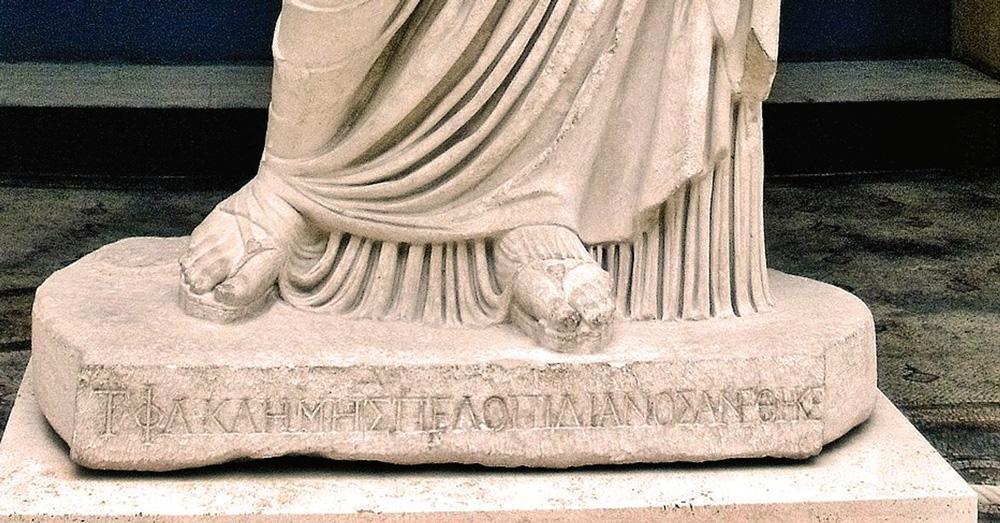
A Tykhe (goddess of fortune) sculpture, which has been smuggled from the southern province of Antalya’s Perge, has been reported to be at the Royal Museums of Fine Arts of Belgium in Brussels.

On the base of the sculpture the name T(itus) Fl(avius) Clemens Pelopidianus is written.
Akdeniz University Associate Professor Nihal Tüner and French professor Hadrien Bru, who are working on Perge inscriptions, as well as Burdur Mehmet Akif Ersoy University academic Assistant Professor Ünal Demirer, who is maintaining the Perge theater sculptures, had jointly published an article in 2015.
They concluded their academic work titled “stone blocks with inscriptions found in the western street” with a publication titled “Inscritions de Perge - Zeitschrift für Papyrologie und Epigraph.”
The article, one of the inscriptions, found in Perge, mentioned the name “Titus Phlavius Clemens Pelopidianos,” a noble family in the city.

Later on, researchers found out that this name was also mentioned in another place, too.
In light of this information, Demirer found that the sculpture in Brussels was smuggled from Perge and informed the Culture and Tourism Ministry about the issue. The ministry got in touch with the museum in Brussels in 2016. But the museum, which had no intent to return the sculpture, said that it was added to the museum collection in 1968 before the 1970 UNESCO Convention. But some historical artifacts that were smuggled from Turkey before this convention were returned by some countries.
Another important evidence of this fact was provided by Antalya Museum Director Mustafa Demirel. In 2015, Demirel found a 1.95-meter-long 2nd century A.D. Aphrodite sculpture, whose two arms were broken and next to its naked feet was Eros, whose wings were half open. “T.Fl. Clemens Pelopidianos” was written in the Greek language on the base of the sculpture.
The inscription, published by the researchers, is like the identity tag of a noble family that had connections with Artemis of Perge. The inscription also has the name of those who donated a sculpture to Perge and the Artemis nuns. One of these names belongs to a woman, Julia Severa, who had connections with the Roman dynasty. She also had family ties with Phoenicia and Galatia. She was also known as an important person in the ancient city of Acmonia in the western province of Uşak’s Banaz district.
Julia Severa’s name, again in connection with Tykhe, “Goddess of Destiny,” also appeared in a case of mosaic smuggling from the ancient city of Acmonia in Uşak.
As I’ve written in an article published in daily Cumhuriyet on Sept. 24, 2001, “When the goddess of destiny Tykhe in the majestic mosaic covering the floor of a Roman gymnasium unearthed in the ancient city of Acmonia in Uşak was unable to resist its fate, it was stolen by thieves despite gendarmerie control.”

“Even though security forces arrested six people involved in the theft on May 22, they were released by a court. The mosaics, 7.5 meters in width and rounded at the top, depicts sports games such as volleyball, boxing, wrestling, and paintings of Tykhe on two corners. One of the Tykhes reads ‘festival organizers’ while the other reads ‘sports organizers.’ A table and three award bags also draw attention in the mosaics. The mosaic also has parts which have naturally been damaged by time. It was reported that after the gendarmerie finished their patrol duty in the middle of the night, the thieves cut the part reading ‘festival organizers’ in a triangle.”
About one year after this incident, a person, who I don’t want to name, said he would come from Istanbul and tell me about the “Tykhe mosaic.” I took him to the Financial Offences Branch of the Police Headquarters. Some officials from the General Directorate of Monuments and Museums that I informed also participated in this meeting.
The informant told them what he had told me at the meeting. I waited for further developments and did not publish them. Then I wrote an article for Cumhuriyet.
“One year ago, the Tykhe mosaic, which was stolen five days after it was unearthed during archaeological excavations in the Ahlat village in Uşak’s Banaz district and delivered to the gendarmerie, was seized in Istanbul. İsmail Çetin, Mehmet Emin Alpsar, Hasan Ünsal and Ramazan Yıldırım were taken under custody in an operation in an office in Maltepe [Istanbul district],” the article said.
Another Tykhe sculpture was found in Perge in 2014 and is currently on display at the Antalya Museum.

I hope Culture and Tourism Minister Numan Kurtulmuş, who has vowed to be working on it like “a detective,” brings back the Tykhe sculpture in Brussels.